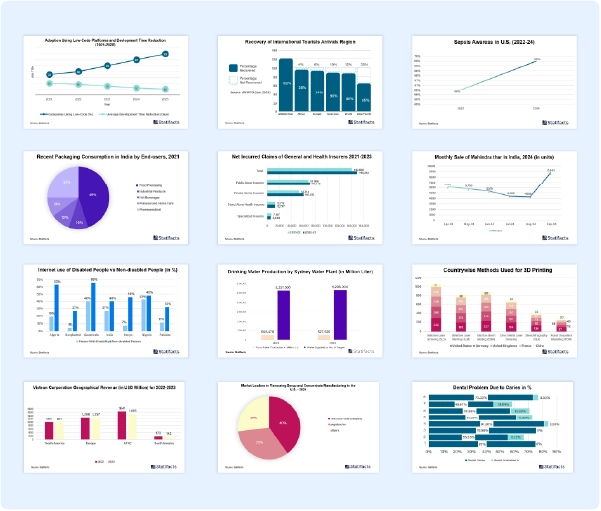The U.S. lung cancer diagnostics market size was estimated at USD 4,779 million in 2024 and is projected to be worth around USD 10,414 million by 2034, growing at a CAGR of 8.1% from 2025 to 2034.
U.S. Lung Cancer Diagnostics Market Report Highlights
- By type, the non-small cell lung cancer (NSCLC) segment dominated the U.S. lung cancer diagnostics market with the highest revenue in 2024.
- By type, the The small-cell lung cancer (SCLC) is expected to be the fastest-growing region during the forecast period.
- By test, the EGFR mutation test will dominate the U.S. lung cancer diagnostics market in 2024.
- By test, the HER2 test segment is expected to grow fastest during the forecast period.
- By End Use, the hospitals and clinics segment dominated the U.S. lung cancer diagnostics market in 2024.
- By End Use, the diagnostic laboratories segment is expected to be the fastest growing during the forecast period.
The U.S. lung cancer diagnostics market refers to the production, distribution, and application of lung cancer diagnostics. The first step in diagnosing lung cancer through lung cancer is through imaging tools, including CT scans, which use X-rays to create cross-sectional images of the chest. MRI scans use radio waves and strong magnets to create detailed images of soft tissue. PET-CT stands for positron emission tomography, and computerized tomography can show where there are active cancer cells. This can help with diagnosis and choosing the best treatment. Lung cancer forms in tissues in the lung, generally in the cells lining air passages. LDCT scans can help find abnormal lung areas that may be cancerous. The main advantage of lung cancer screening is preventing death from lung cancer. The main aim of lung cancer screening is to detect lung cancer at as an early stage as possible, which increases the likelihood of remission. Cancer diagnosis is important because the delivery of high-quality health care depends on accurate and timely diagnosis.
The rise in lung cancer incidence is largely driven by environmental factors like air pollution and smoking and the aging population contributing to the growth of the U.S. lung cancer diagnostics market. Lung cancer screening with Low Dose Computerized Tomography in high-risk individuals can reduce lung cancer mortality by 20%-26% and all-cause mortality by 7%. Lung cancer is most easily and effectively treated when it is found at an early stage. Lung cancer is the one of the leading causes of cancer-related deaths globally, accounting for the highest cancer-related mortality rates among both men and women. Smoking is the leading cause of lung cancer, accounting for 85% of all cases. Lung cancer incidence and mortality increased with age, peaking in the 70-79 age group among males and the 60-69 age group for females. Around 9 out of 10 people who get lung cancer are smokers or ex-smokers.
Advanced technology in lung cancer diagnostics is playing a significant role in the growth of the U.S. lung cancer diagnostics market. Recent advances in diagnostic technologies in lung cancer include screening with LDCT rather than conventional chest radiography, which is efficient in detecting small lung nodules, leads to early intervention, and enhances the prognosis of lung cancer patients. By using advanced technology, diagnosing lung cancer can become as easy as inhaling nanoparticle sensors and then taking a urine test that reveals whether a tumor is present. In new diagnostic methods, nanosensors are delivered by inhalers or nebulizers. Advanced technology in lung cancer diagnostics benefits also include increased job opportunities, global knowledge access, new jobs, cheaper manufacturing of products, improved storage, higher safety, improved competitiveness, higher safety, increased production, better communication, access to information, and boost productivity.
Artificial intelligence (AI) based diagnostic system has the potential to help pathologists rapidly detect mutated genes in lung cancer, making the early initiation of targeted drug therapy to enhance treatment outcomes and patient prognosis. AI models have become an effective tool in lung cancer diagnosis, enhancing accuracy, efficiency, and stability. AI can closely scan CT scans to identify scans in the lungs and assess who may be at risk for developing lung cancer in the future. This advancement may allow for earlier diagnosis and treatment. The AI model recognizes patterns representing cell and tissue types and how those components interact better, allowing pathologists to assess cancer risk. With the development of AI, deep learning (DL) and convolutional neural networks (CNNs) have shown their massive potential in detecting pulmonary nodules and are effective in segmenting and classifying the nodules. The main aim of AI is to implement human intelligence in machines so that the machine can act like a human. These factors help the growth of the U.S. lung cancer diagnostics market.
Published by
Deepa Pandey

